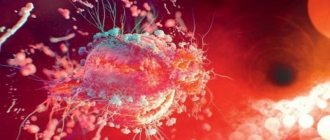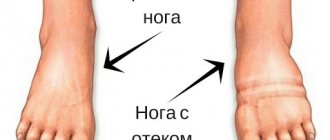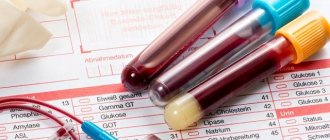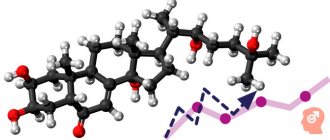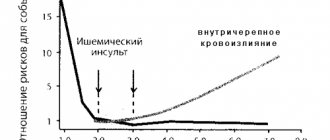Description:
Lactate dehydrogenase (LDH) exists in body tissues in the form of a tetramer: two monomers, H and M, can combine in different ratios to form the five known LDH isoenzymes. The enzyme catalyzes the reaction of converting pyruvic acid into lactic acid with the participation of NADH, as well as the reverse reaction. This reaction is the final stage of the anaerobic mechanism of glucose oxidation:
pyruvate + NADH + H+ ↔ L-lactate + NAD+
In some pathological conditions, an increase in LDH activity is observed, for example, with acute liver damage, with damage to skeletal muscles and kidneys, with megaloblastic and hemolytic anemia. In lymphoma, high plasma LDH activity predicts a poor prognosis. There is a relationship between enzyme activity and tumor volume, so sequential measurements of LDH activity levels make it possible to evaluate the effectiveness of therapy.
In both cardiac muscle and erythrocytes, LDH is represented mainly by LDH isoenzymes (H4). The isoenzyme exhibits much greater catalytic activity towards α-hydroxybutyrate than lactate (compared to other isoenzymes), therefore, when measuring LDH activity, this substrate is used. The second name of the LDH isoenzyme is α-hydroxybutyrate dehydrogenase (HBD).
Determining the level of activity of LDH isoenzymes is important in cases of suspected myocardial infarction and in the diagnosis of hemolytic crisis in sickle cell anemia.
Enzyme functions
{banner_banstat0}
Lactate dehydrogenase in the blood is a specific cellular enzyme that is responsible for energy metabolism: the breakdown of glucose and the acceleration of the transformation of lactic acid into pyruvic acid. Cellular enzymes are nonspecific in terms of identifying pathological processes. Fluctuations in LDH in one direction or another can be diagnosed in dozens of pathologies, since LDH is not consumed on its own, but only stimulates the rate of biochemical reactions tens of times.
For a more accurate diagnosis, modifications of LDH are examined, of which there are 5 options:
- LDH-1 is a marker of the cardiovascular or renal system;
- LDH-2 – characterizes the condition of the lymph nodes or spleen;
- LDH-3 – lungs;
- LDH-4 – placenta in pregnant women;
- LDH-5 – liver and skeletal muscle tissue.
Isoenzymes are diagnosed infrequently, only if a targeted assessment of LDH concentration is necessary, which always remains at the discretion of specialists.
Reasons for the increase
{banner_banstat3}
In most cases, further examination requires an increase in indicators. The reasons for the increase in enzyme concentration in men and women are explained by the destruction of cells, when the maximum amount of LDH enters the bloodstream. Minimization of lactate dehydrogenase levels is observed during tumor processes in the liver or cirrhosis of the organ.
Reasons for increased LDH:
- AMI: an increase in lactate dehydrogenase is one of the main diagnostic signs of a developing infarction, the maximum of the enzyme is recorded on the first day from the onset of the attack, the high concentration remains for two weeks, while the degree of LDH activity is directly proportional to the scale of myocardial necrosis (to help, a study of LDH-1 is carried out, which increases tenfold);
- an increase in liver enzymes in the blood: the presence of ALT and AST in the bloodstream is a consequence of the breakdown of hepatocytes of any origin, which is directly related to an increase in LDH activity;
- TELA;
- tumor growth in the liver, kidneys, metastasis;
- blood cancer;
- anemia of various etiologies: poisoning with salts of heavy metals or incorrect blood transfusion - hemolytic anemia, Addison's syndrome - lack of vitamin B12, and so on;
- degenerative-destructive changes in muscles of any origin;
- pyelo- or glomerulonephritis;
- viral infection of the lymphatic system, including the spleen (mononucleosis)
- pancreatitis, pancreatic necrosis;
- intestinal infarction;
- fractures;
- hypothyroidism;
- convulsions of various etiologies;
- delirium tremens;
- severe gestosis in the second half of pregnancy;
- burns with a large surface area;
- pneumocystis pneumonia;
- premature placental abruption;
- coronary insufficiency;
- decompensated pathologies of the heart muscle;
- gangrene;
- chemotherapy.
Reasons for the downgrade
{banner_banstat4}
Decreased lactate dehydrogenase levels are less common. Reasons for low LDH concentrations may include:
- inadequate drug therapy: ascorbic acid, anticonvulsants, cytostatics, immunosuppressants, antibiotics, hormones;
- fluctuations in pH levels due to the formation of oxalates;
- genetic problems.
When LDH decreases, all medications except those that are vital need to be discontinued.
It should be noted that fluctuations in LDH can be caused by non-pathological triggers: violation of the rules for blood sampling, sports training, overexertion of any kind on the eve of the analysis, thrombocytosis, exacerbation of skin diseases, hemodialysis, and the perinatal period in women.
Additional diagnostic methods
{banner_banstat5}
The essence of correcting LDH levels is treating the root cause. For this, correct and timely diagnosis of the pathology that causes the enzyme to deviate from the norm is extremely important. Enzyme blood testing is carried out: liver and cardiac enzymes AST and ALT (aspartate aminotransferase, alanine aminotransferase), muscle protein creatine phosphokinase (CPK), alkaline phosphatase (ALP), globular protein troponin, myoglobin - a protein that binds oxygen, and all LDH isoenzymes are determined.
Additionally prescribed: ultrasound, MRI, CT, depending on the expected localization of the pathological process.
Preparation and delivery of analysis
{banner_banstat1}
The procedure is no different from a standard blood test; no special preparation rules are required. Blood is donated on an empty stomach (fasting period of at least 10 hours). On the eve of the test, it is recommended to minimize physical activity, exclude fatty foods, and a day before - exclude alcohol, cigarettes, and coffee. In addition, it is necessary to coordinate the use of anticoagulants, hormones, ascorbic acid, and NSAIDs with your doctor.
Blood is taken from a vein in the morning. Decoding is carried out by comparing the results obtained with reference values. The analysis is ready in a day. If an emergency assessment of the patient’s condition is necessary, blood is taken without any preparation.
The analysis is carried out in a laboratory in compliance with the rules of asepsis and antisepsis, a blood sample is placed in a labeled tube, the concentration of LDH is calculated, the results are given to the patient or sent to the attending physician who referred for the analysis.
Lactate dehydrogenase (LDH)
Lactate dehydrogenase (LDH) is an intracellular glycolytic enzyme that is involved in the reversible conversion of lactate to pyruvate and is found in most tissues of the body.
Research method
UV kinetic test.
Units
U/L (unit per liter).
What biomaterial can be used for research?
Venous blood.
How to properly prepare for research?
- Do not eat for 12 hours before the test.
- Avoid physical and emotional stress 30 minutes before the test.
- Do not smoke for 30 minutes before donating blood.
General information about the study
Lactate dehydrogenase (LDH) is a zinc-containing intracellular enzyme that catalyzes the oxidation of lactic acid to pyruvate. LDH is most active in skeletal muscle, cardiac muscle, kidneys, liver and red blood cells.
There are five different forms (isoenzymes) of LDH, which differ in molecular structure and location in the body.
In diseases accompanied by tissue damage and cell destruction, LDH activity in the blood increases. In this regard, it is an important marker of tissue destruction. Despite the fact that an increase in enzyme activity does not indicate a specific disease, its determination in combination with other laboratory tests helps in the diagnosis of pulmonary infarction, muscular dystrophy and hemolytic anemia. Increased LDH activity can be detected in newborns, pregnant women and after intense physical exercise. for dynamic monitoring of cancer patients.
What is the research used for?
- To diagnose acute or chronic tissue damage during a comprehensive examination of the patient.
- For differential diagnosis of diseases with severe pain in the chest (myocardial infarction, angina, pulmonary infarction).
- To identify diseases accompanied by hemolysis of red blood cells.
- To monitor the course of cancer during therapy.
- For the study of liver and kidney pathologies.
- For diagnosing muscle tissue lesions.
What do the results mean?
| Age, gender | Reference values |
| 6 – 12 years | |
| 12 - 17 years old | |
| > 17 years old, female | 135 - 214 U/l |
| > 17 years old, male | 135 - 225 U/l |
Reasons for increased activity of general lactate dehydrogenase:
- myocardial infarction,
- pulmonary embolism and pulmonary infarction,
- blood diseases accompanied by hemolysis,
- malignant neoplasms of various localizations,
- leukemia,
- liver pathology,
- kidney disease (kidney infarction, glomerulonephritis, pyelonephritis),
- muscle pathology (muscular dystrophy, injury, atrophy),
- bone fractures,
- congestive heart failure, acute coronary failure,
- Infectious mononucleosis,
- intestinal infarction,
- acute pancreatitis,
- stroke,
- convulsive seizure,
- traumatic shock,
- severe conditions accompanied by hypoxia, hyper- and hypothermia,
- burn disease,
- hypothyroidism
Important Notes
Due to the non-specificity of this analysis, its result should be interpreted taking into account the indicators of other laboratory tests and the clinical picture of the disease.
Indications for examination
Laboratory biochemical blood tests are methods of primary, indicative diagnosis, which set the correct vector for further examination of the patient. The study of LDH is aimed at identifying hematological, cardiac, muscle pathologies, and tumor growth.
Indications for prescribing an LDH blood test are:
- persistent symptomatic complaints of the patient;
- medical examination, medical examination, screening;
- monitoring the adequacy of prescribed treatment;
- preparation for surgery.
LDH determination is carried out if:
- anemia;
- angina pectoris;
- AMI or suffered on the legs;
- liver pathologies: cancer, cirrhosis, hepatitis of any origin;
- chronic renal failure;
- pneumonia;
- pancreatitis or other pancreatic lesions;
- lymphadenitis;
- myositis;
- leukemia or other blood tumors;
- intoxication of any etiology;
- sepsis;
- enlarged spleen;
- decay of internal organs of any origin, including traumatic;
- condition after chemotherapy;
- differential diagnosis of infections, which is associated with the study of cerebrospinal fluid).
Normal indicators for men, women, children
{banner_banstat2}
The normal level of LDH in the blood in children and adolescents is correlated with age, and in adults – by gender. The LDH level in women is 20% higher than in men. The measurement value for lactate dehydrogenase is U/L. Average standardized values (reference values) are available only in childhood; in adult men and women, the range of indicators is stable. As part of advanced diagnostics, isoenzymes are also examined. Decoding is the prerogative of the doctor.
The norm tables are presented below:
| Age | Norm of indicator in U/l |
| Newborns | Does not exceed 450 |
| Up to 3 years | Around 355 |
| Until 6 | No more than 310 |
| Up to 12 | Doesn't go beyond 330 |
| Before 18 | Not higher than 270 |
| After 18 | From 130 to 210 in men (on average from 135 to 225) From 130 to 232 in women (on average from 135 to 214) |
A slight increase in reference values was noted among professional athletes and pregnant women.
Deviation of values from the accepted norm is a reason for advanced diagnostics.

